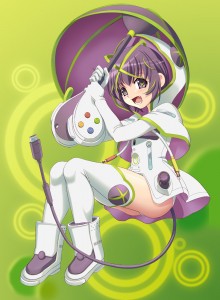Akihiko Yoshida Leaves Square Enix
As another year passes, yet another iconic Square Enix talent flees the sinking and rudderless vessel – all while Tetsuya Nomura, Motomu Toriyama, and Yoshinori Kitase consolidate their influence over all things Final Fantasy. This week Akihiko Yoshida announced his departure from Square Enix through a personal message within an artbook accompanying the release of Bravely Default: For the Sequel, a Japanese re-release of the international version of Bravely Default, which also launches in PAL territories this week.
“This is a personal message of mine, but I’d like to say thank you for all the support these past 18 years. I have decided to leave Square Enix, but I believe our relationship will continue going on.
And as long as I’m needed [laughs,] I will continue working on the Bravely Default series. Thank you for your continued support.
Bravely Default main character designer & lead artist,
Akihiko Yoshida”
Yoshida first came to prominence for his art direction and character design work at Enix [by way of Quest] under Yasumi Matsuno, which saw his involvement with Ogre Battle and Tactics Ogre. He then joined Squaresoft where, once again under Matsuno, he was heavily associated with the Final Fantasy brand, predominantly for his work on the Ivalice sub-series. His notable works while at Squaresoft/Square Enix include: Final Fantasy Tactics, Vagrant Story, Final Fantasy XII, Final Fantasy XIV [both vanilla and A Realm Reborn], and Bravely Default.
As Yoshida mentions in his departure message, he still intends to be party to future collaborations with Square Enix, and indeed has already been confirmed to be reprising his duties for Bravely Second, the sequel to Bravely Default. This is heartening, but at the same time we have all seen that when Square Enix staff leave the company to go freelance it tends to result in less future Square Enix work for them, and on smaller projects too. This ultimately means less of an influence over the future direction of the Final Fantasy series. At any rate, one wonders what ultimately led Yoshida to make his decision to leave the company. In fervent anticipation for the release of Bravely Default, one likes to think that it was his experience of working with a smaller group of people on a creative passion-project which led to Akihiko Yosida’s desire to step away from the corporate banality of modern day Square Enix.
Pornhub Reveals the Viewing Proclivities of Gamers
Quite why anyone would use their console of choice as a means to peruse hardcore pornography when a computer or even a smartphone would be vastly preferable is beyond the ken of this particular news hack, yet apparently it is a big thing, as evidenced by Pornhub’s early official support of the PS4.
According to Pornhub, their console traffic has a lower bounce rate than regular traffic; meaning that console users tend to view more pages and stay for a longer duration. This may have something to do with the relative ease of browsing for content via PC, and the luxury of being able to open up many concurrent tabs; then again, perhaps console owners, by their nature, are just massively creepy pervs.
Surprisingly, despite the relatively parity between PS3 and 360 sales, the PS3 accounts for 55% of Pornhub’s console traffic to 360’s 39% [with Wii bringing up the rear with 6%]. It is not quite clear what has led to this apparent disparity between console user-bases – perhaps PS3 owners are just naturally pervy people, or perhaps Americans are less inclined to view pornography than are Asians and Europeans. Alternately, perhaps this apparent disparity is merely the result of the Xbox 360s artificial install-base, as individuals who buy second and third replacement 360s are viewed as unique users rather than return customers.
While the 55% figure might paint PS3 users as creepy perverts, it is important to note that the most popular pornography genre for PS3 and PS4 owners is the relatively conservative ‘MILF’ category, which contrasts starkly with the 360’s favoured ‘Teen’ category, and the Wii’s favoured ‘Hentai’ category [consolidating the Wii’s position as the Wiiaboo console of choice]. Further, out of the PS3, PS4, 360, and Wii, Nintendo users were the only demography to exhibit an interest in the ‘Big Dick’ genre [bringing up the rear indeed!].
Activision Blames Console Transition for Poor COD Sales
Call of Duty: Ghosts is easily the best selling launch title on both PS4 and Xbone, it has also achieved sales figures on the PS3 and 360 that would make any other publisher green with envy – yet these sales also represent a precipitous halving of Call of Duty‘s retail fortunes. Game reviewers have often been far softer judges of Call of Duty‘s annualised laziness than have gamers in general, yet Call of Duty: Ghosts‘ lack of innovation proved to be too much for even some longtime Call of Duty apologists like Jim Sterling, and they turned on the game. In contrast to the mid-80s to low-90s Metacritic scores to which the series is accustomed, Call of Duty: Ghosts only managed to score in the mid-70s, a first for the series. This [and quite possibly word of mouth] has led to a sharp decline in series sales, from 24.4 million worldwide with Call of Duty: Black Ops II to 10.9 million worldwide with Call of Duty: Ghosts. In all fairness, Call of Duty: Black Ops II has obviously been on the market for a lot longer than Call of Duty: Ghosts, but then in all fairness the vast majority of Call of Duty purchases have always come from its first two weeks on sale.
According to Activision the poor sales result of Call of Duty: Ghosts has nothing to do with the perceived quality of the title, nor Call of Duty series fatigue in general, but rather it has occured due to the changeover of console generations, which obviously impacts Call of Duty sales because of [?].
“We’ve been pretty transparent all year that we think, because of the challenges of the console transition year, that that was likely in the short-term. I think it would be a mistake to conflate the challenges of the console transition year with any indications about the health of the franchise.
I know that Call of Duty’s a polarising franchise with some of the critics, and it’s clear to me that not all the critics like our strategy of making a game every year, but thankfully our fans do.
It’s also clear to me that the critical response doesn’t always mirror the fans’ appreciation of a game. We actually do read the critics’ comments and take them into consideration during our creative process, but we just can’t measure ourselves by that yardstick alone.”
Critical response may not always mirror fan appreciation of a game, yet in this instance it appears that fan appreciation of Call of Duty: Ghosts has mirrored its retail performance. It is all very well to cite some intangible, unprovable quantity as being to blame for the fact than the iterative milking of Call of Duty has finally caught up with the series, but then one would love to know how Activision are able to reconcile the record-breaking launch of Grand Theft Auto V which was released a scant handful of weeks ago, and went on to sell a cool 25.94 million units across two gaming platforms.


